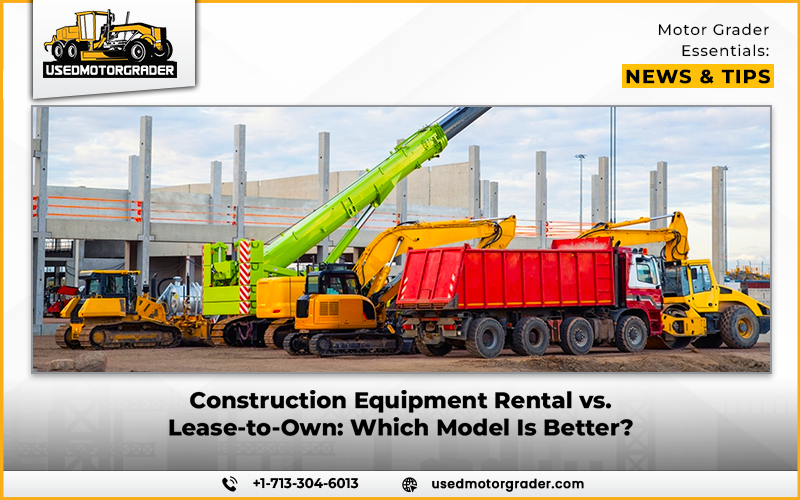Best Approach for Cash Flow
When Equipment Access Becomes a Cash Flow Decision
More and more, construction companies are not buying each machine outright. Since conditions on the job can change quickly, many construction companies now choose to be flexible instead of holding onto fixed assets. When deciding between construction equipment rental or entering a lease-to-own agreement, the central question often becomes: which option preserves your working capital and protects your cash flow better?. The solution depends on your organization’s plans, approach to usage, and how you set up your financial arrangements.
Understanding Short-Term Rentals: Flexibility with a Price Tag
When you need fast service, an urgent rental, or a project isn’t worth a purchase, construction equipment rental is the way to go. With renting, you can take a machine whenever you want, keep it for a short time, and then give it back, without being tied down. It’s perfect when your trucks are busy during high seasons or when you urgently need more capacity. Still, this kind of service isn’t cheap. Rental schedules, whether daily or weekly, are a lot more expensive than owning or leasing for a longer term. Most of the time, you’re not buying the asset, but paying for access, and if you rent often, these costs can quickly add up.
Lease-to-Own Basics: Deferred Ownership with Predictable Terms
With lease-to-own, you get options between construction equipment rental and buying. For months or years, you make scheduled payments, and at the end, the equipment becomes your property. With this model, you can be sure about your costs. You are aware of your regular bills, and those bills are adding up to something you will own later on. It takes more time to buy a home, but it means your payments are not as heavy and it’s simpler to predict your finances.
Cash Flow Considerations: Who Wins the Month-to-Month Cost Battle?
When you rent, your books stay clean, and you don’t have to worry about debts or machine expenses that go unused. That’s good news for contractors trying to keep their operations simple and flexible. If your job takes longer or you get several at once, rent can become very expensive. With lease-to-own, you make the same payment each month, which is usually less than you would pay for renting. Work that you know you’ll get every month can make your cash flow smoother. You get more value from renting: one week of dozer rental is less than leasing, but one whole year rents out to be much cheaper. It’s just here that lease-to-own starts to improve your financial situation.
Risk and Responsibility: Who Covers Repairs, Insurance, and Downtime?
It is at this stage that the models take very different paths. During your rental, the company looks after maintenance, registration, and insurance for you. Any time something breaks, they fix it. The price you pay for the rental includes that peace of mind. The warranty usually lasts for a little while, but you take on a lot of that responsibility once it ends. Taking care of the equipment and repair bills can be expensive if you didn’t budget correctly. Still, leasing gives you the ability to make more decisions. You don’t have to worry about rental rules or availability, and the machine starts yours right away.
Project Matching: When Each Model Makes More Financial Sense
Not every job does not requires planning equipment needs far into the future. For example, emergency repairs and trial grading can be done well with rental equipment. You rent something now, give it back when you’re done, and that’s it. Leasing becomes a better fit when you know your crew will be using the machine for an extended time. If you are awarded long-term sitework or utility grading contracts, it is a smart financial decision to tie a machine to your workload with a lease-to-own arrangement. By renting, you’re using what you need and saving for the day you own.
Equipment Utilization Rates: The Hidden Metric That Changes the Math
Most contractors overlook the importance of utilization when making their choice. If a machine will see service three days a month, it’s more helpful to rent it instead of buying. If instead, your machine operates for 80 hours a month, spreading the cost over those hours on a lease-to-own plan can make your hourly expenditure much lower. If you track usage correctly, you will find out which model works best for your company. It is wise to invest in high-utilization machinery for a long period. If a facility is used little, it’s most economical to rent or invite a contractor to take over.
Long-Term Value and Resale: Does Ownership Pay Off in the End?
Renting or buying equipment can bring value to your business even when it’s not on the site. If you maintain your heavy machinery, it will likely be worth a lot when you trade it in or sell it. That’s an advantage over renting, since your payments do not go anywhere once the bill has been paid. When you own your home, you face the possibility of it losing value when the market changes. With lease-to-own, you can count on fixed payments and the freedom to sell whenever you’d like. When you plan to regularly change or upgrade your fleet, the value you build while leasing can help you more than paying rentals several times over.


